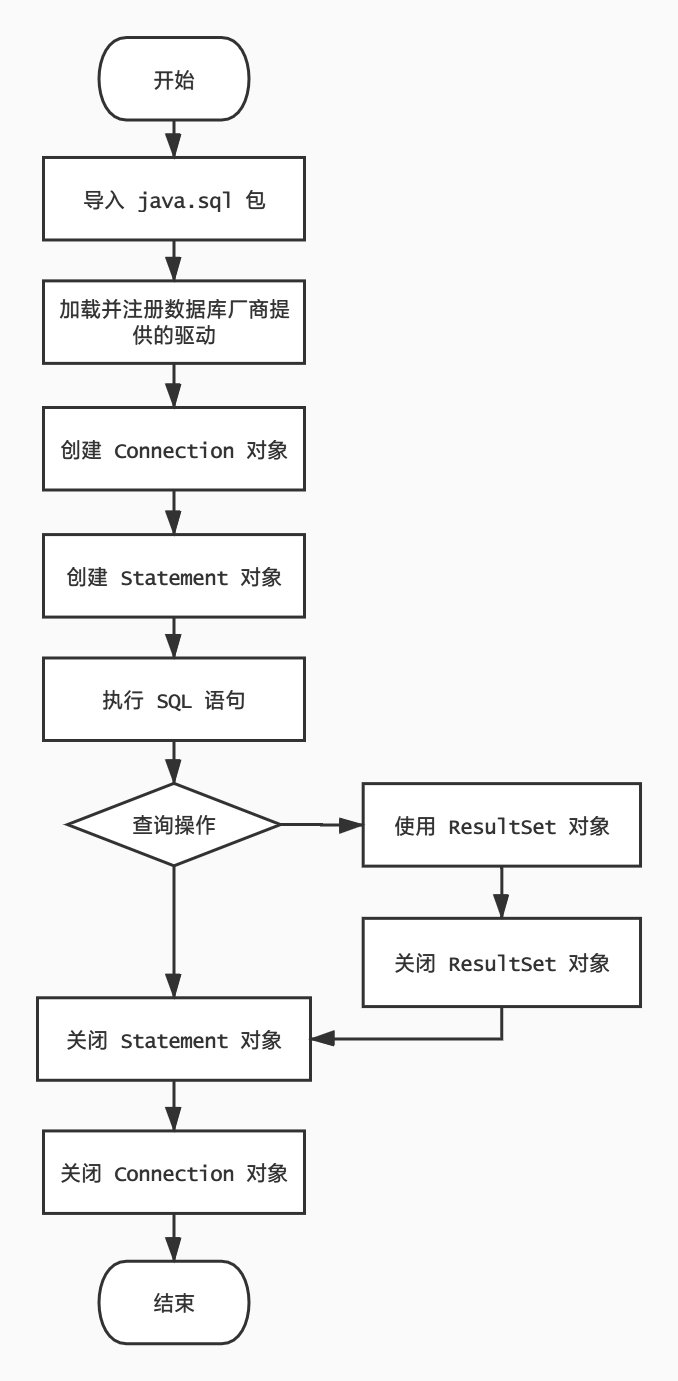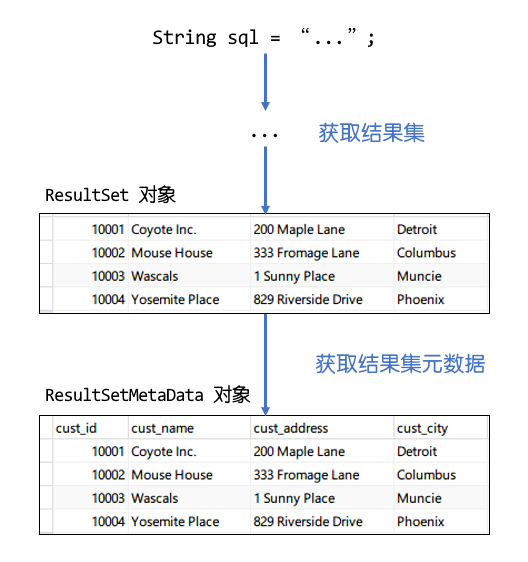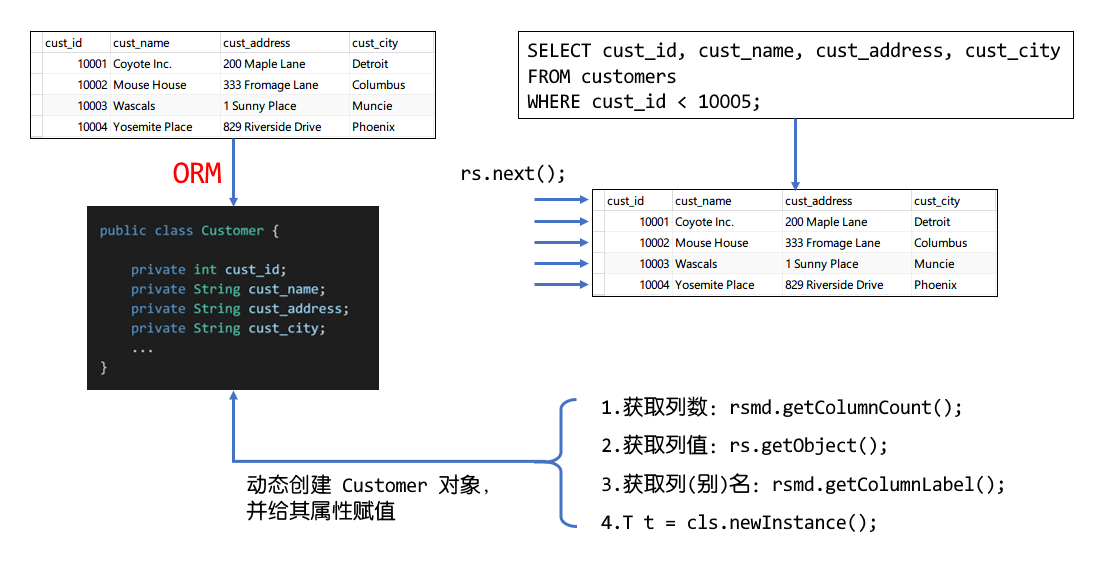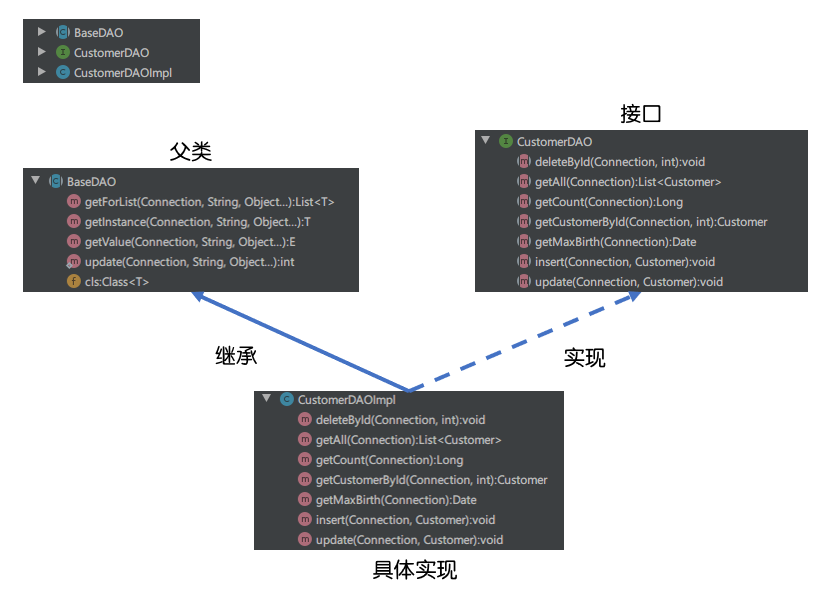Java 数据库连接,(Java Database Connectivity,简称JDBC)是 Java 语言中用来规范客户端程序如何来访问数据库的应用程序接口,提供了诸如查询和更新数据库中数据的方法。JDBC是面向关系型数据库的。
1. JDBC 概述 1.1 Java 中的数据存储技术 在 Java中,数据库存取技术可分为如下几类:
JDBC 直接访问数据库
JDO (Java Data Object )技术
第三方 O/R 工具,如 Hibernate, Mybatis 等
JDO、Hibernate、MyBatis 等更好的封装了 JDBC。
1.2 JDBC 介绍 JDBC(Java Database Connectivity)是一个独立于特定数据库管理系统、通用的 SQL 数据库存取和操作的公共接口 (一组API),定义了用来访问数据库的标准Java类库,使用这些类库可以以一种标准 的方法、方便地访问数据库资源。
JDBC为访问不同的数据库提供了一种统一的途径 ,为开发者屏蔽了一些细节问题。
使用 JDBC 可以连接任何提供了JDBC驱动程序 的数据库系统,这样就使得程序员无需对特定的数据库系统的特点有过多的了解,从而大大简化和加快了开发过程。
1.3 JDBC 体系结构 JDBC接口(API)包括两个层次:
JDBC 是 Sun 公司提供一套用于数据库操作的接口,程序员只需要面向这套接口编程即可。不同的数据库厂商,需要针对这套接口,提供不同实现。不同的实现的集合,即为不同数据库的驱动。——面向接口编程
1.4 JDBC 程序编写步骤
2. 获取数据库连接 四个要素:Driver 接口实现类、URL、用户名、密码。
1 2 3 4 5 6 7 8 9 10 11 12 13 14 15 16 17 18 19 20 21 @Test public void getConnection () throws Exception InputStream is = ConnectionTest.class.getClassLoader().getResourceAsStream("jdbc.properties"); BufferedInputStream bis = new BufferedInputStream(is); Properties pros = new Properties(); pros.load(bis); String user = pros.getProperty("user" ); String password = pros.getProperty("password" ); String url = pros.getProperty("url" ); String driverClass = pros.getProperty("driverClass" ); Class.forName(driverClass); Connection conn = DriverManager.getConnection(url, user, password); System.out.println(conn); }
其中,配置文件声明在工程的src目录下:【jdbc.properties】
1 2 3 4 user =root password =admin url =jdbc:mysql://localhost:3306/test driverClass =com.mysql.jdbc.Driver
使用配置文件的好处:
获取连接和关闭资源是常用操作,将其包装为一个工具类:JDBCUtils.java
1 2 3 4 5 6 7 8 9 10 11 12 13 14 15 16 17 18 19 20 21 22 23 24 25 26 27 28 29 30 31 32 33 34 35 36 37 38 39 40 41 42 43 44 45 46 47 48 49 50 51 52 53 54 55 56 57 58 59 60 61 62 63 64 65 66 67 68 69 70 71 72 73 74 75 76 77 78 79 80 81 82 83 84 85 86 87 88 89 90 91 92 93 94 95 96 97 98 99 100 101 102 103 104 105 106 107 108 109 110 111 112 public class JDBCUtils private JDBCUtils () public static Connection getConnection () throws Exception InputStream is = ClassLoader.getSystemClassLoader().getResourceAsStream("jdbc.properties" ); BufferedInputStream bis = new BufferedInputStream(is); Properties properties = new Properties(); properties.load(bis); String user = properties.getProperty("user" ); String password = properties.getProperty("password" ); String url = properties.getProperty("url" ); String driverClass = properties.getProperty("driverClass" ); Class.forName(driverClass); Connection conn = DriverManager.getConnection(url, user, password); return conn; } public static void closeResourse (Connection conn, Statement ps) try { if (conn != null ) { conn.close(); } } catch (SQLException e) { e.printStackTrace(); } try { if (ps != null ) { ps.close(); } } catch (SQLException e) { e.printStackTrace(); } } public static void closeResourse (Connection conn, Statement ps, ResultSet rs) try { if (conn != null ) { conn.close(); } } catch (SQLException e) { e.printStackTrace(); } try { if (ps != null ) { ps.close(); } } catch (SQLException e) { e.printStackTrace(); } try { if (rs != null ) { rs.close(); } } catch (SQLException e) { e.printStackTrace(); } } }
3. 使用 PreparedStatement 实现 CRUD 操作 3.1 操作和访问数据库 数据库连接被用于向数据库服务器发送命令和 SQL 语句,并接受数据库服务器返回的结果。一个数据库连接就是一个Socket连接。
在 java.sql 包中有 3 个接口分别定义了对数据库的调用的不同方式:
Statement:用于执行静态 SQL 语句并返回它所生成结果的对象。
PreparedStatement:SQL 语句被预编译并存储在此对象中,可以使用此对象多次高效地执行该语句。
CallableStatement:用于执行 SQL 存储过程
3.2 使用 Statement 操作数据表的弊端 通过调用 Connection 对象的 createStatement() 方法创建该对象。该对象用于执行静态的 SQL 语句,并且返回执行结果。
Statement 接口中定义了下列方法用于执行 SQL 语句:
方法
说明
int excuteUpdate(String sql)
执行更新操作 INSERT、UPDATE、DELETE
ResultSet executeQuery(String sql)
执行查询操作 SELECT
但是使用 Statement 操作数据表存在弊端:
问题一:存在拼串操作,繁琐 问题二:存在 SQL 注入问题
SQL 注入是利用某些系统没有对用户输入的数据进行充分的检查,而在用户输入数据中注入非法的 SQL 语句段或命令(如:SELECT user, password FROM user_table WHERE user=’a’ OR 1 = ‘ AND password = ‘ OR ‘1’ = ‘1’) ,从而利用系统的 SQL 引擎完成恶意行为的做法。
对于 Java 而言,要防范 SQL 注入,只要用 PreparedStatement(从Statement扩展而来) 取代 Statement 就可以了。
3.3 PreparedStatement 的使用 3.3.1 PreparedStatement 介绍 可以通过调用 Connection 对象的 preparedStatement(String sql) 方法获取 PreparedStatement 对象
PreparedStatement 接口是 Statement 的子接口,它表示一条预编译过的 SQL 语句。
An object that represents a precompiled SQL statement.
PreparedStatement 对象所代表的 SQL 语句中的参数用问号(?)来表示,调用 PreparedStatement 对象的 setXxx() 方法来设置这些参数. setXxx() 方法有两个参数,第一个参数是要设置的 SQL 语句中的参数的索引(从 1 开始),第二个是设置的 SQL 语句中的参数的值。
3.3.2 PreparedStatement vs Statement PreparedStatement 能最大可能提高性能:
DBServer 会对预编译 语句提供性能优化。因为预编译语句有可能被重复调用,所以语句在被DBServer的编译器编译后的执行代码被缓存下来,那么下次调用时只要是相同的预编译语句就不需要编译,只要将参数直接传入编译过的语句执行代码中就会得到执行。
在 Statement 语句中,即使是相同操作但因为数据内容不一样,所以整个语句本身不能匹配,没有缓存语句的意义.事实是没有数据库会对普通语句编译后的执行代码缓存。这样每执行一次都要对传入的语句编译一次。
(语法检查,语义检查,翻译成二进制命令,缓存)
PreparedStatement 可以防止 SQL 注入。
3.3.3 Java 与 SQL 对应数据类型转换表
Java 类型
SQL 类型
boolean
BIT
byte
TINYINT
short
SMALLINT
int
INTEGER
long
BIGINT
String
CHAR,VARCHAR,LONGVARCHAR
byte array
BINARY, VAR BINARY
java.sql.Date
DATE
java.sql.Time
TIME
java.sql.Timestamp
TIMESTAMP
3.3.4 使用 PreparedStatement 实现增、删、改操作 1 2 3 4 5 6 7 8 9 10 11 12 13 14 15 16 17 18 19 20 21 22 23 24 25 26 27 28 29 public static void update (String sql, Object ... args) Connection conn = null ; PreparedStatement ps = null ; try { conn = JDBCUtils.getConnection(); ps = conn.prepareStatement(sql); for (int i = 0 ; i < args.length; i++) { ps.setObject(i + 1 , args[i]); } ps.executeUpdate(); } catch (Exception e) { e.printStackTrace(); } finally { JDBCUtils.closeResourse(conn, ps); } }
3.3.5 使用 PreparedStatement 实现查询操作 1 2 3 4 5 6 7 8 9 10 11 12 13 14 15 16 17 18 19 20 21 22 23 24 25 26 27 28 29 30 31 32 33 34 35 36 37 38 39 40 41 42 43 44 45 46 47 48 49 50 51 public <T> T getInstance (Class<T> cls, String sql, Object ... args) { Connection conn = null ; PreparedStatement ps = null ; ResultSet rs = null ; try { conn = JDBCUtils.getConnection(); ps = conn.prepareStatement(sql); for (int i = 0 ; i < args.length; i++) { ps.setObject(i + 1 , args[i]); } rs = ps.executeQuery(); ResultSetMetaData metaData = rs.getMetaData(); int columnCount = metaData.getColumnCount(); if (rs.next()) { T t = cls.newInstance(); for (int i = 0 ; i < columnCount; i++) { Object columValue = rs.getObject(i + 1 ); String columnLabel = metaData.getColumnLabel(i + 1 ); Field field = cls.getDeclaredField(columnLabel); field.setAccessible(true ); field.set(t, columValue); } return t; } } catch (Exception e) { e.printStackTrace(); } finally { JDBCUtils.closeResourse(conn, ps, rs); } return null ; }
1 2 3 4 5 6 7 8 9 10 11 12 13 14 15 16 17 18 19 20 21 22 23 24 25 26 27 28 29 30 31 32 33 34 35 36 37 38 39 40 41 42 43 44 45 46 47 48 49 50 51 52 53 public <T> List<T> getForList (Class<T> cls, String sql, Object ... args) { Connection conn = null ; PreparedStatement ps = null ; ResultSet rs = null ; try { conn = JDBCUtils.getConnection(); ps = conn.prepareStatement(sql); for (int i = 0 ; i < args.length; i++) { ps.setObject(i + 1 , args[i]); } rs = ps.executeQuery(); ResultSetMetaData metaData = rs.getMetaData(); int columnCount = metaData.getColumnCount(); ArrayList<T> list = new ArrayList<>(); while (rs.next()) { T t = cls.newInstance(); for (int i = 0 ; i < columnCount; i++) { Object columValue = rs.getObject(i + 1 ); String columnLabel = metaData.getColumnLabel(i + 1 ); Field field = cls.getDeclaredField(columnLabel); field.setAccessible(true ); field.set(t, columValue); } list.add(t); } return list; } catch (Exception e) { e.printStackTrace(); } finally { JDBCUtils.closeResourse(conn, ps, rs); } return null ; }
3.4.1 ResultSet 查询需要调用 PreparedStatement 的 executeQuery() 方法,查询结果是一个ResultSet 对象。
ResultSet 对象以逻辑表格的形式封装了执行数据库操作的结果集,ResultSet 接口由数据库厂商提供实现。
ResultSet 返回的实际上就是一张数据表。有一个指针指向数据表的第一条记录的前面。
ResultSet 对象维护了一个指向当前数据行的游标 ,初始的时候,游标在第一行之前,可以通过 ResultSet 对象的 next() 方法移动到下一行。调用 next()方法检测下一行是否有效。若有效,该方法返回 true,且指针下移。相当于Iterator对象的 hasNext() 和 next() 方法的结合体。
当指针指向一行时, 可以通过调用 getXxx(int index) 或 getXxx(int columnName) 获取每一列的值。
例如: getInt(1), getString(“name”)
注意:Java 与数据库交互涉及到的相关 Java API 中的索引都从1开始。
ResultSet 接口的常用方法:
boolean next()
getString()
…
可用于获取关于 ResultSet 对象中列的类型和属性信息的对象。
ResultSetMetaData rsmd = rs.getMetaData();
ResultSetMetaData 中的部分抽象方法:
方法
描述
String getColumnName (int column)
获取指定列的名称
String getColumnLabel (int column)
获取指定列的别名
int getColumnCount ()
返回当前 ResultSet 对象中的列数
String getColumnTypeName(int column)
检索指定列的数据库特定的类型名称
int getColumnDisplaySize(int column)
指示指定列的最大标准宽度,以字符为单位
int isNullable (int column)
指示指定列中的值是否可以为 null
boolean isAutoIncrement(int column)
指示是否自动为指定列进行编号,这样这些列仍然是只读的
3.5 资源的释放
释放 ResultSet, Statement,Connection。
数据库连接(Connection)用完后必须马上释放,如果 Connection 不能及时正确的关闭将导致系统宕机。Connection 的使用原则是尽量晚创建,尽量早的释放。
可以在 finally 中关闭,保证及时其他代码出现异常,资源也一定能被关闭。
3.6 小结 两种思想
两种技术
JDBC结果集的元数据:ResultSetMetaData
获取列数:getColumnCount()
获取列的别名:getColumnLabel()
通过反射,创建指定类的对象,获取指定的属性并赋值
4. 操作 BLOB 类型字段 4.1 MySQL BLOB 类型 MySQL中,BLOB 是一个二进制大型对象,是一个可以存储大量数据的容器,它能容纳不同大小的数据。插入BLOB类型的数据必须使用 PreparedStatement,因为 BLOB 类型的数据无法使用字符串拼接写的。
MySQL 的四种 BLOB 类型(除了在存储的最大信息量上不同外,他们是等同的):
类型
大小(单位:字节)
TinyBlob
最大 255
Blob
最大 65K
MediumBlob
最大 16M
LongBlob
最大 4G
实际使用中根据需要存入的数据大小定义不同的 BLOB 类型。如果存储的文件过大,数据库的性能会下降。
如果在指定了相关的 Blob 类型以后,还报错:xxx too large,那么在 MySQL 的安装目录下,找 my.ini 文件加上如下的配置参数: max_allowed_packet=16M。同时注意:修改了my.ini文件之后,需要重新启动 mysql 服务。
4.2 向数据表中插入大数据类型 1 2 3 4 5 6 7 8 9 10 11 12 13 14 15 16 17 18 19 20 21 22 23 24 25 26 27 28 29 30 31 32 33 34 35 36 37 38 39 40 41 42 @Test public void testInsert () Connection conn = null ; PreparedStatement ps = null ; BufferedInputStream bis = null ; try { conn = JDBCUtils.getConnection(); String sql = "INSERT INTO customers (cust_name, cust_address, cust_city, cust_photo) VALUES (?, ?, ?, ?)" ; ps = conn.prepareStatement(sql); ps.setObject(1 , "E Fudd" ); ps.setObject(2 , "4545 53rd Street" ); ps.setObject(3 , "Chicago" ); FileInputStream is = new FileInputStream(new File("Fudd.jpg" )); bis = new BufferedInputStream(is); ps.setBlob(4 , bis); ps.executeUpdate(); } catch (Exception e) { e.printStackTrace(); } finally { try { if (bis != null ) { bis.close(); } } catch (IOException e) { e.printStackTrace(); } JDBCUtils.closeResourse(conn, ps); } }
4.3 从数据表中查询大数据类型 1 2 3 4 5 6 7 8 9 10 11 12 13 14 15 16 17 18 19 20 21 22 23 24 25 26 27 28 29 30 31 32 33 34 35 36 37 38 39 40 41 42 43 44 45 46 47 48 49 50 51 52 53 54 55 56 57 58 59 60 61 62 63 64 65 66 67 68 69 70 @Test public void testQuery () Connection conn = null ; PreparedStatement ps = null ; ResultSet rs = null ; InputStream is = null ; FileOutputStream os = null ; BufferedInputStream bis = null ; BufferedOutputStream bos = null ; try { conn = JDBCUtils.getConnection(); String sql = "SELECT cust_id, cust_name, cust_address, cust_city, cust_photo FROM customers WHERE id = ?" ; ps = conn.prepareStatement(sql); ps.setObject(1 , 10001 ); rs = ps.executeQuery(); if (rs.next()) { int cust_id = rs.getInt("cust_id" ); String cust_name = rs.getString("cust_name" ); String cust_address = rs.getString("cust_address" ); String cust_city = rs.getString("cust_city" ); Customer customer = new Customer(cust_id, cust_name, cust_address, cust_city); System.out.println(customer); Blob photo = rs.getBlob("photo" ); is = photo.getBinaryStream(); os = new FileOutputStream("photo.jpg" ); bis = new BufferedInputStream(is); bos = new BufferedOutputStream(os); byte [] buffer = new byte [1024 ]; int len = 0 ; while ( (len = bis.read(buffer)) != -1 ) { bos.write(buffer, 0 , len); } } } catch (Exception e) { e.printStackTrace(); } finally { try { if (bos != null ) { bos.close(); } } catch (IOException e) { e.printStackTrace(); } try { if (bis != null ) { bis.close(); } } catch (IOException e) { e.printStackTrace(); } JDBCUtils.closeResourse(conn, ps, rs); } }
5. 批量操作 5.1 批量执行 SQL 语句 当需要成批插入或者更新记录时,可以采用 Java 的批量更新机制,这一机制允许多条语句一次性提交给数据库批量处理。通常情况下比单独提交处理效率更高。
JDBC 的批量处理语句包括下面三个方法:
addBatch(String):添加需要批量处理的SQL语句或是参数; executeBatch():执行批量处理语句; clearBatch():清空缓存的数据
通常会遇到两种批量执行SQL语句的情况:
多条SQL语句的批量处理;
一个SQL语句的批量传参;
5.2 高效的批量插入 向数据表中插入 1000000 条数据
1 2 3 4 CREATE TABLE goods(id INT PRIMARY KEY AUTO_INCREMENT,NAME VARCHAR (20 ));
1 2 3 4 5 6 7 8 9 10 11 12 13 14 15 16 17 18 19 20 21 22 23 24 25 26 27 28 29 30 31 32 33 34 35 36 37 38 39 40 41 42 43 44 45 46 47 @Test public void testInsert3 () Connection conn = null ; PreparedStatement ps = null ; try { long startTime = System.currentTimeMillis(); conn = JDBCUtils.getConnection(); conn.setAutoCommit(false ); String sql = "INSERT INTO goods(name) VALUES (?)" ; ps = conn.prepareStatement(sql); for (int i = 1 ; i <= 1000000 ; i++) { ps.setObject(1 , "name_" + i); ps.addBatch(); if ( i % 500 == 0 ) { ps.executeBatch(); ps.clearBatch(); } } conn.commit(); long endTime = System.currentTimeMillis(); System.out.println("时间为:" + (endTime - startTime) + " ms." ); } catch (Exception e) { e.printStackTrace(); } finally { JDBCUtils.closeResourse(conn, ps); } }
6. 数据库事务 6.1 数据库事务介绍 事务 :一组逻辑操作单元,使数据从一种状态变换到另一种状态。
事务处理(事务操作): 保证所有事务都作为一个工作单元来执行,即使出现了故障,都不能改变这种执行方式。当在一个事务中执行多个操作时,要么所有的事务都被 提交(commit) ,那么这些修改就永久地保存下来;要么数据库管理系统将放弃所作的所有修改,整个事务 回滚(rollback) 到最初状态。
为确保数据库中数据的 一致性 ,数据的操纵应当是离散的成组的逻辑单元:当它全部完成时,数据的一致性可以保持,而当这个单元中的一部分操作失败,整个事务应全部视为错误,所有从起始点以后的操作应全部回退到开始状态。
6.2 JDBC 事务处理 数据一旦提交,就不可回滚。
数据什么时候意味着提交?
当一个连接对象被创建时,默认情况下是自动提交事务 :每次执行一个 SQL 语句时,如果执行成功,就会向数据库自动提交,而不能回滚。关闭数据库连接,数据就会自动的提交。 如果多个操作,每个操作使用的是自己单独的连接,则无法保证事务。即同一个事务的多个操作必须在同一个连接下。
JDBC 程序中为了让多个 SQL 语句作为一个事务执行:
调用 Connection 对象的 setAutoCommit(false); 以取消自动提交事务
在所有的 SQL 语句都成功执行后,调用 commit(); 方法提交事务
在出现异常时,调用 rollback(); 方法回滚事务
若此时 Connection 没有被关闭,还可能被重复使用,则需要恢复其自动提交状态 setAutoCommit(true)。尤其是在使用数据库连接池技术时,执行 close() 方法前,建议恢复自动提交状态。
【案例:用户 AA 向用户 BB 转账100】
1 2 3 4 5 6 7 8 9 10 11 12 13 14 15 16 17 18 19 20 21 22 23 24 25 26 27 28 29 30 31 32 33 34 35 36 37 38 39 40 41 42 43 44 45 public void testJDBCTransaction () Connection conn = null ; try { conn = JDBCUtils.getConnection(); conn.setAutoCommit(false ); String sql1 = "UPDATE user_table SET balance = balance - 100 WHERE user = ?" ; update(conn, sql1, "AA" ); String sql2 = "UPDATE user_table SET balance = balance + 100 WHERE user = ?" ; update(conn, sql2, "BB" ); conn.commit(); } catch (Exception e) { e.printStackTrace(); try { conn.rollback(); } catch (SQLException e1) { e1.printStackTrace(); } } finally { try { conn.setAutoCommit(true ); } catch (SQLException e) { e.printStackTrace(); } JDBCUtils.closeResource(conn, null , null ); } } }
其中,对数据库操作的方法为:
1 2 3 4 5 6 7 8 9 10 11 12 13 14 15 16 17 18 19 20 21 22 23 24 25 26 27 public static int update (Connection conn, String sql, Object ... args) PreparedStatement ps = null ; try { ps = conn.prepareStatement(sql); for (int i = 0 ; i < args.length; i++) { ps.setObject(i + 1 , args[i]); } return ps.executeUpdate(); } catch (Exception e) { e.printStackTrace(); } finally { JDBCUtils.closeResourse(null , ps); } return 0 ; }
6.3 事务的 ACID 属性
原子性(Atomicity)
一致性(Consistency)
隔离性(Isolation)
持久性(Durability)
6.3.1 数据库的并发问题 对于同时运行的多个事务, 当这些事务访问数据库中相同的数据时, 如果没有采取必要的隔离机制, 就会导致各种并发问题:
脏读 : 对于两个事务 T1, T2, T1 读取了已经被 T2 更新但还没有被提交 的字段。之后, 若 T2 回滚, T1读取的内容就是临时且无效的。不可重复读 : 对于两个事务T1, T2, T1 读取了一个字段, 然后 T2 更新 了该字段。之后, T1再次读取同一个字段, 值就不同了。幻读 : 对于两个事务T1, T2, T1 从一个表中读取了一个字段, 然后 T2 在该表中插入 了一些新的行。之后, 如果 T1 再次读取同一个表, 就会多出几行。
数据库事务的隔离性 : 数据库系统必须具有隔离并发运行各个事务的能力, 使它们不会相互影响, 避免各种并发问题。
一个事务与其他事务隔离的程度称为隔离级别。数据库规定了多种事务隔离级别, 不同隔离级别对应不同的干扰程度, 隔离级别越高, 数据一致性就越好, 但并发性越弱。
6.3.2 四种隔离级别 数据库提供的 4 种事务隔离级别:
Oracle 支持的 2 种事务隔离级别:READ COMMITED , SERIALIZABLE。 Oracle 默认的事务隔离级别为: READ COMMITED 。
MySQL 支持 4 种事务隔离级别。MySQL 默认的事务隔离级别为: REPEATABLE READ。
6.3.3 在 MySQL 中设置隔离级别 每启动一个 MySQL 程序, 就会获得一个单独的数据库连接. 每个数据库连接都有一个全局变量 @@tx_isolation, 表示当前的事务隔离级别。
查看当前的隔离级别:
设置当前 MySQL 连接的隔离级别:
1 SET transaction isolation level read committed;
设置数据库系统的全局的隔离级别:
1 SET global transaction isolation level read committed;
补充操作:
创建 MySQL 数据库用户:
1 create user tom identified by 'abc123';
授予权限
1 2 3 4 5 #授予通过网络方式登录的 Jeremy 用户,对所有库所有表的全部权限,密码设为abc123. grant all privileges on *.* to Jeremy@'%' identified by 'abc123'; #给 Jeremy 用户使用本地命令行方式,授予atguigudb这个库下的所有表的插删改查的权限。 grant select,insert,delete,update on atguigudb.* to Jeremy@localhost identified by 'abc123';
7. DAO 及相关实现类 DAO:Data Access Object访问数据信息的类和接口,包括了对数据的CRUD(Create、Retrival、Update、Delete),而不包含任何业务相关的信息。有时也称作:BaseDAO。
作用:为了实现功能的模块化,更有利于代码的维护和升级。
customers 表的字段
层次结构:
【BaseDAO.java】
1 2 3 4 5 6 7 8 9 10 11 12 13 14 15 16 17 18 19 20 21 22 23 24 25 26 27 28 29 30 31 32 33 34 35 36 37 38 39 40 41 42 43 44 45 46 47 48 49 50 51 52 53 54 55 56 57 58 59 60 61 62 63 64 65 66 67 68 69 70 71 72 73 74 75 76 77 78 79 80 81 82 83 84 85 86 87 88 89 90 91 92 93 94 95 96 97 98 99 100 101 102 103 104 105 106 107 108 109 110 111 112 113 114 115 116 117 118 119 120 121 122 123 124 125 126 127 128 129 130 131 132 133 134 135 136 137 138 139 140 141 142 143 144 145 146 147 148 149 150 151 152 153 154 155 156 157 158 159 160 161 162 163 164 165 166 167 168 169 170 171 172 173 174 175 176 177 178 179 180 181 182 183 184 185 186 187 188 189 190 191 192 193 194 195 196 197 198 199 200 201 202 203 204 205 206 207 208 209 210 211 212 213 214 215 216 217 218 219 public abstract class BaseDAO <T > private Class<T> cls = null ; { Type genericSuperclass = this .getClass().getGenericSuperclass(); ParameterizedType paramType = (ParameterizedType) genericSuperclass; Type[] typeArguments = paramType.getActualTypeArguments(); cls = (Class<T>) typeArguments[0 ]; } public static int update (Connection conn, String sql, Object ... args) PreparedStatement ps = null ; try { ps = conn.prepareStatement(sql); for (int i = 0 ; i < args.length; i++) { ps.setObject(i + 1 , args[i]); } return ps.executeUpdate(); } catch (Exception e) { e.printStackTrace(); } finally { JDBCUtils.closeResourse(null , ps); } return 0 ; } public T getInstance (Connection conn, String sql, Object ... args) PreparedStatement ps = null ; ResultSet rs = null ; try { ps = conn.prepareStatement(sql); for (int i = 0 ; i < args.length; i++) { ps.setObject(i + 1 , args[i]); } rs = ps.executeQuery(); ResultSetMetaData metaData = rs.getMetaData(); int columnCount = metaData.getColumnCount(); if (rs.next()) { T t = cls.newInstance(); for (int i = 0 ; i < columnCount; i++) { Object columValue = rs.getObject(i + 1 ); String columnLabel = metaData.getColumnLabel(i + 1 ); Field field = cls.getDeclaredField(columnLabel); field.setAccessible(true ); field.set(t, columValue); } return t; } } catch (Exception e) { e.printStackTrace(); } finally { JDBCUtils.closeResourse(null , ps, rs); } return null ; } public List<T> getForList (Connection conn, String sql, Object ... args) PreparedStatement ps = null ; ResultSet rs = null ; try { ps = conn.prepareStatement(sql); for (int i = 0 ; i < args.length; i++) { ps.setObject(i + 1 , args[i]); } rs = ps.executeQuery(); ResultSetMetaData metaData = rs.getMetaData(); int columnCount = metaData.getColumnCount(); ArrayList<T> list = new ArrayList<>(); while (rs.next()) { T t = cls.newInstance(); for (int i = 0 ; i < columnCount; i++) { Object columValue = rs.getObject(i + 1 ); String columnLabel = metaData.getColumnLabel(i + 1 ); Field field = cls.getDeclaredField(columnLabel); field.setAccessible(true ); field.set(t, columValue); } list.add(t); } return list; } catch (Exception e) { e.printStackTrace(); } finally { JDBCUtils.closeResourse(null , ps, rs); } return null ; } public <E> E getValue (Connection conn, String sql, Object ... args) { PreparedStatement ps = null ; try { ps = conn.prepareStatement(sql); for (int i = 0 ; i < args.length; i++) { ps.setObject(i + 1 , args[i]); } ResultSet rs = ps.executeQuery(); if (rs.next()) { return (E) rs.getObject(1 ); } } catch (SQLException e) { e.printStackTrace(); } finally { JDBCUtils.closeResourse(null , ps); } return null ; } }
【CustomerDAO.java】
1 2 3 4 5 6 7 8 9 10 11 12 13 14 15 16 17 18 19 20 21 22 23 24 25 26 27 28 29 30 31 32 33 34 35 36 37 38 39 40 41 42 43 44 45 46 47 48 49 50 51 52 53 54 55 56 57 58 59 60 61 62 63 64 65 66 67 68 69 70 71 72 73 74 75 76 77 78 79 80 81 82 83 84 85 86 87 88 89 90 91 92 93 94 95 96 97 public interface CustomerDAO void insert (Connection conn, Customer cust) void deleteById (Connection conn, int id) void update (Connection conn, Customer cust) Customer getCustomerById (Connection conn, int id) ; List<Customer> getAll (Connection conn) ; Long getCount (Connection conn) ; Date getMaxBirth (Connection conn) ; }
【CustomerDAOImpl.java】
1 2 3 4 5 6 7 8 9 10 11 12 13 14 15 16 17 18 19 20 21 22 23 24 25 26 27 28 29 30 31 32 33 34 35 36 37 38 39 40 41 42 43 44 45 46 47 48 49 50 51 52 53 54 55 56 57 public class CustomerDAOImpl extends BaseDAO <Customer > implements CustomerDAO @Override public void insert (Connection conn, Customer cust) String sql = "INSERT INTO customers (name, email, birth) VALUES (?, ?, ?)" ; update(conn, sql, cust.getName(), cust.getEmail(), cust.getBirth()); } @Override public void deleteById (Connection conn, int id) String sql = "DELETE FROM customers WHERE id = ?" ; update(conn, sql,id); } @Override public void update (Connection conn, Customer cust) String sql = "UPDATE customers SET name = ?, email = ?, birth = ? WHERE id = ?" ; update(conn, sql, cust.getName(), cust.getEmail(), cust.getBirth(), cust.getId()); } @Override public Customer getCustomerById (Connection conn, int id) String sql = "SELECT id, name, email, birth FROM customers WHERE id = ?" ; return getInstance(conn, sql, id); } @Override public List<Customer> getAll (Connection conn) String sql = "SELECT id, name, email, birth FROM customers" ; return getForList(conn, sql); } @Override public Long getCount (Connection conn) String sql = "SELECT COUNT(*) FROM customers" ; return getValue(conn, sql); } @Override public Date getMaxBirth (Connection conn) String sql = "SELECT MAX(birth) FROM customers" ; return getValue(conn, sql); } }
8. 数据库连接池 8.1 JDBC 数据库连接池的必要性 在使用开发基于数据库的 web 程序时,传统的模式基本是按以下步骤:
在主程序(如servlet、beans)中建立数据库连接 进行 sql 操作 断开数据库连接
这种模式开发,存在的问题:
普通的 JDBC 数据库连接使用 DriverManager 来获取,每次向数据库建立连接的时候都要将 Connection 加载到内存中,再验证用户名和密码(得花费0.05s~1s的时间)。需要数据库连接的时候,就向数据库要求一个,执行完成后再断开连接。这样的方式将会消耗大量的资源和时间。 数据库的连接资源并没有得到很好的重复利用。 若同时有几百人甚至几千人在线,频繁的进行数据库连接操作将占用很多的系统资源,严重的甚至会造成服务器的崩溃。
对于每一次数据库连接,使用完后都得断开。 否则,如果程序出现异常而未能关闭,将会导致数据库系统中的内存泄漏,最终将导致重启数据库。这种开发不能控制被创建的连接对象数 ,系统资源会被毫无顾及的分配出去,如连接过多,也可能导致内存泄漏,服务器崩溃。
8.2 数据库连接池技术 为解决传统开发中的数据库连接问题,可以采用数据库连接池技术。
数据库连接池的基本思想 :就是为数据库连接建立一个“缓冲池”。预先在缓冲池中放入一定数量的连接,当需要建立数据库连接时,只需从“缓冲池”中取出一个,使用完毕之后再放回去。
数据库连接池 负责分配、管理和释放数据库连接,它允许应用程序重复使用一个现有的数据库连接,而不是重新建立一个 。
数据库连接池在初始化时将创建一定数量的数据库连接放到连接池中,这些数据库连接的数量是由最小数据库连接数来设定 的。无论这些数据库连接是否被使用,连接池都将一直保证至少拥有这么多的连接数量。连接池的最大数据库连接数量 限定了这个连接池能占有的最大连接数,当应用程序向连接池请求的连接数超过最大连接数量时,这些请求将被加入到等待队列中。
数据库连接池技术的优点:
资源重用
由于数据库连接得以重用,避免了频繁创建,释放连接引起的大量性能开销。在减少系统消耗的基础上,另一方面也增加了系统运行环境的平稳性。
更快的系统反应速度
数据库连接池在初始化过程中,往往已经创建了若干数据库连接置于连接池中备用。此时连接的初始化工作均已完成。对于业务请求处理而言,直接利用现有可用连接,避免了数据库连接初始化和释放过程的时间开销,从而减少了系统的响应时间
新的资源分配手段
对于多应用共享同一数据库的系统而言,可在应用层通过数据库连接池的配置,实现某一应用最大可用数据库连接数的限制,避免某一应用独占所有的数据库资源
统一的连接管理,避免数据库连接泄漏
在较为完善的数据库连接池实现中,可根据预先的占用超时设定,强制回收被占用连接,从而避免了常规数据库连接操作中可能出现的资源泄露
8.3 多种开源的数据库连接池 JDBC 的数据库连接池使用 javax.sql.DataSource 来表示,DataSource 只是一个接口,该接口通常由服务器(Weblogic, WebSphere, Tomcat)提供实现,也有一些开源组织提供实现:
DBCP 是Apache提供的数据库连接池。Tomcat 服务器自带dbcp数据库连接池。速度相对 c3p0 较快 ,但因自身存在BUG,Hibernate3已不再提供支持。C3P0 是一个开源组织提供的一个数据库连接池,速度相对较慢,稳定性还可以。 hibernate官方推荐使用。Proxool 是 SourceForge下 的一个开源项目数据库连接池,有监控连接池状态的功能,稳定性较 c3p0 差一点 BoneCP 是一个开源组织提供的数据库连接池,速度快。Druid 是阿里提供的数据库连接池,监控做的很好。
DataSource 通常被称为数据源,它包含连接池和连接池管理两个部分,习惯上也经常把 DataSource 称为连接池。DataSource 用来取代 DriverManager 来获取 Connection,获取速度快,同时可以大幅度提高数据库访问速度。
目前使用较多的是 Druid。
注意:
数据源和数据库连接不同,数据源无需创建多个,它是产生数据库连接的工厂,因此整个应用只需要一个数据源即可。
当数据库访问结束后,程序还是像以前一样关闭数据库连接:conn.close(); 但 conn.close() 并没有关闭数据库的物理连接,它仅仅把数据库连接释放,归还给了数据库连接池。
8.3.1 C3P0 数据库连接池
1 2 3 4 5 6 7 8 9 10 11 12 13 14 15 16 17 public static Connection testGetConnection () throws Exception ComboPooledDataSource cpds = new ComboPooledDataSource(); cpds.setDriverClass( "com.mysql.jdbc.Driver" ); cpds.setJdbcUrl( "jdbc:mysql://localhost:3306/test" ); cpds.setUser("root" ); cpds.setPassword("admin" ); cpds.setInitialPoolSize(10 ); Connection conn = cpds.getConnection(); return conn; }
1 2 3 4 5 6 ComboPooledDataSource cpds = new ComboPooledDataSource("c3p0" ); public static Connection testGetConnection () throws Exception Connection conn = cpds.getConnection(); return conn; }
其中,src 下的配置文件为:【c3p0-config.xml】
1 2 3 4 5 6 7 8 9 10 11 12 13 14 15 16 17 18 19 20 21 22 23 24 25 <?xml version="1.0" encoding="UTF-8"?> <c3p0-config > <named-config name ="c3p0" > <property name ="driverClass" > com.mysql.jdbc.Driver</property > <property name ="jdbcUrl" > jdbc:mysql://localhost:3306/test</property > <property name ="user" > root</property > <property name ="password" > admin</property > <property name ="acquireIncrement" > 50</property > <property name ="initialPoolSize" > 10</property > <property name ="minPoolSize" > 10</property > <property name ="maxPoolSize" > 100</property > <property name ="maxStatements" > 50</property > <property name ="maxStatementsPerConnection" > 2</property > </named-config > </c3p0-config >
8.3.2 DBCP 数据库连接池
DBCP 是 Apache 下的开源连接池实现,该连接池依赖该组织下的另一个开源系统:Common-pool。如需使用该连接池实现,应在系统中增加如下两个 jar 文件:
Commons-dbcp.jar:连接池的实现
Commons-pool.jar:连接池实现的依赖库
Tomcat 的连接池正是采用该连接池来实现的。 该数据库连接池既可以与应用服务器整合使用,也可由应用程序独立使用。数据源和数据库连接不同,数据源无需创建多个,它是产生数据库连接的工厂,因此整个应用只需要一个数据源即可。
当数据库访问结束后,程序还是像以前一样关闭数据库连接:conn.close(); 但上面的代码并没有关闭数据库的物理连接,它仅仅把数据库连接释放,归还给了数据库连接池。
1 2 3 4 5 6 7 8 9 10 11 12 13 14 15 16 17 18 19 20 public static Connection testGetConnection () throws SQLException BasicDataSource source = new BasicDataSource(); source.setDriverClassName( "com.mysql.jdbc.Driver" ); source.setUrl( "jdbc:mysql://localhost:3306/test" ); source.setUsername( "root" ); source.setPassword( "admin" ); source.setInitialSize(10 ); source.setMaxActive(10 ); Connection conn = source.getConnection(); return conn; }
1 2 3 4 5 6 7 8 9 10 11 12 13 14 15 16 17 18 19 20 21 22 23 24 25 private static DataSource source = null ;static { try { Properties pros = new Properties(); InputStream is = ClassLoader.getSystemClassLoader().getResourceAsStream("dbcp.properties" ); BufferedInputStream bis = new BufferedInputStream(is); pros.load(bis); source = BasicDataSourceFactory.createDataSource(pros); } catch (Exception e) { e.printStackTrace(); } } public static Connection getConnection6 () throws Exception Connection conn = source.getConnection(); return conn; }
其中,src 下的配置文件为:【dbcp.properties】
1 2 3 4 5 6 7 8 driverClassName =com.mysql.jdbc.Driver url =jdbc:mysql://localhost:3306/test username =root password =admin initialSize =10 maxActive =10
8.3.3 Druid(德鲁伊)数据库连接池 Druid 是阿里巴巴开源平台上一个数据库连接池实现,它结合了C3P0、DBCP、Proxool等DB池的优点,同时加入了日志监控,可以很好的监控DB池连接和SQL的执行情况,可以说是针对监控而生的DB连接池。
1 2 3 4 5 6 7 8 9 10 11 12 13 public static Connection getConnection () throws Exception InputStream is = ClassLoader.getSystemClassLoader().getResourceAsStream("druid.properties" ); BufferedInputStream bis = new BufferedInputStream(is); Properties pros = new Properties(); pros.load(bis); DataSource source = DruidDataSourceFactory.createDataSource(pros); Connection conn = source.getConnection(); return conn; }
其中,src下的配置文件为:【druid.properties】
1 2 3 4 5 6 7 8 9 url=jdbc:mysql: username=root password=admin driverClassName=com.mysql.jdbc.Driver # 根据需要设置参数 initialSize=10 maxActive=10 #...
9. Apache-DBUtils 实现 CRUD 操作 9.1 Apache-DBUtils 简介 commons-dbutils 是 Apache 组织提供的一个开源 JDBC工具类库,它是对JDBC的简单封装,学习成本极低,并且使用dbutils能极大简化jdbc编码的工作量,同时也不会影响程序的性能。
API介绍:
org.apache.commons.dbutils.QueryRunner
org.apache.commons.dbutils.ResultSetHandler
工具类:org.apache.commons.dbutils.DbUtils
9.2 主要 API 的使用 9.2.1 DbUtils DbUtils :提供如关闭连接、装载JDBC驱动程序等常规工作的工具类,里面的所有方法都是静态的。主要方法如下:
public static void close(…) throws java.sql.SQLException : DbUtils类提供了三个重载的关闭方法。这些方法检查所提供的参数是不是NULL,如果不是的话,它们就关闭Connection、Statement和ResultSet。public static void closeQuietly(…): 这一类方法不仅能在Connection、Statement和ResultSet为NULL情况下避免关闭,还能隐藏一些在程序中抛出的SQLEeception。
public static void commitAndClose(Connection conn)throws SQLException: 用来提交连接的事务,然后关闭连接
public static void commitAndCloseQuietly(Connection conn): 用来提交连接,然后关闭连接,并且在关闭连接时不抛出SQL异常。
public static void rollback(Connection conn)throws SQLException:允许conn为null,因为方法内部做了判断
public static void rollbackAndClose(Connection conn)throws SQLException
rollbackAndCloseQuietly(Connection)
public static boolean loadDriver(java.lang.String driverClassName):这一方装载并注册JDBC驱动程序,如果成功就返回true。使用该方法,你不需要捕捉这个异常ClassNotFoundException。
9.2.2 QueryRunner 类 该类简单化了SQL查询,它与ResultSetHandler组合在一起使用可以完成大部分的数据库操作,能够大大减少编码量。
QueryRunner类提供了两个构造器:
默认的构造器
需要一个 javax.sql.DataSource 来作参数的构造器
QueryRunner类的主要方法:
更新
public int update(Connection conn, String sql, Object… params) throws SQLException:用来执行一个更新(插入、更新或删除)操作。
……
插入
public T insert(Connection conn,String sql,ResultSetHandler rsh, Object… params) throws SQLException:只支持INSERT语句,其中 rsh - The handler used to create the result object from the ResultSet of auto-generated keys. 返回值: An object generated by the handler.即自动生成的键值
批处理
public int[] batch(Connection conn,String sql,Object[][] params)throws SQLException: INSERT, UPDATE, or DELETE语句
public T insertBatch(Connection conn,String sql,ResultSetHandler rsh,Object[][] params)throws SQLException:只支持INSERT语句
…..
查询
public Object query(Connection conn, String sql, ResultSetHandler rsh,Object… params) throws SQLException:执行一个查询操作,在这个查询中,对象数组中的每个元素值被用来作为查询语句的置换参数。该方法会自行处理 PreparedStatement 和 ResultSet 的创建和关闭。
测试
1 2 3 4 5 6 7 8 9 10 11 12 13 14 15 16 17 18 19 20 @Test void testInsert () Connection conn = null ; try { conn = JDBCUtils.getConnection3(); String sql = "INSERT INTO customers(name, email, birth) VALUES (?,?,?)" ; QueryRunner runner = new QueryRunner(); int insertCount = runner.update(conn, sql, "Jerry" , "jerry@sina.com" , "2002-06-01" ); System.out.println("添加了 " + insertCount + " 条记录" ); } catch (SQLException e) { e.printStackTrace(); } finally { JDBCUtils.closeResourse(conn, null ); } }
9.2.3 ResultSetHandler 接口及实现类 该接口用于处理 java.sql.ResultSet,将数据按要求转换为另一种形式。
ResultSetHandler 接口提供了一个单独的方法:Object handle (java.sql.ResultSet .rs)。
接口的主要实现类:
实现类
描述
ArrayHandler
把结果集中的第一行数据转成对象数组
ArrayListHandler
把结果集中的每一行数据都转成一个数组,再存放到List中
BeanHandler 将结果集中的第一行数据封装到一个对应的JavaBean实例中
BeanListHandler 将结果集中的每一行数据都封装到一个对应的JavaBean实例中,存放到List里
ColumnListHandler
将结果集中某一列的数据存放到List中
KeyedHandler(name)
将结果集中的每一行数据都封装到一个Map里,再把这些map再存到一个map里,其key为指定的key
MapHandler 将结果集中的第一行数据封装到一个Map里,key是列名,value就是对应的值
MapListHandler: 将结果集中的每一行数据都封装到一个Map里,然后再存放到List
ScalarHandler: 查询单个值对象
测试
1 2 3 4 5 6 7 8 9 10 11 12 13 14 15 16 17 18 19 20 21 22 23 24 25 @Test void testQuery1 () Connection conn = null ; try { conn = JDBCUtils.getConnection(); QueryRunner runner = new QueryRunner(); String sql = "SELECT id, name, email, birth FROM customers WHERE id = ?" ; BeanHandler<Customer> handler = new BeanHandler<>(Customer.class ) ; Customer customer = runner.query(conn, sql, handler, 10 ); System.out.println(customer); } catch (SQLException e) { e.printStackTrace(); } finally { JDBCUtils.closeResourse(conn, null ); } }
1 2 3 4 5 6 7 8 9 10 11 12 13 14 15 16 17 18 19 20 21 22 23 24 25 @Test void testQuery2 () throws SQLException Connection conn = null ; try { conn = JDBCUtils.getConnection(); QueryRunner runner = new QueryRunner(); String sql = "SELECT id, name, email, birth FROM customers WHERE id < ?" ; BeanListHandler<Customer> handler = new BeanListHandler<>(Customer.class ) ; List<Customer> customers = runner.query(conn, sql, handler, 10 ); customers.forEach(System.out::println); } catch (SQLException e) { e.printStackTrace(); } finally { JDBCUtils.closeResourse(conn, null ); } }
1 2 3 4 5 6 7 8 9 10 11 12 13 14 15 16 17 18 19 20 21 22 23 24 @Test void testQuery3 () Connection conn = null ; try { conn = JDBCUtils.getConnection(); QueryRunner runner = new QueryRunner(); String sql = "SELECT id, name, email, birth FROM customers WHERE id = ?" ; MapHandler handler = new MapHandler(); Map<String, Object> map = runner.query(conn, sql, handler, 10 ); System.out.println(map); } catch (SQLException e) { e.printStackTrace(); } finally { JDBCUtils.closeResourse(conn, null ); } }
1 2 3 4 5 6 7 8 9 10 11 12 13 14 15 16 17 18 19 20 21 22 23 24 @Test void testQuery4 () Connection conn = null ; try { conn = JDBCUtils.getConnection(); QueryRunner runner = new QueryRunner(); String sql = "SELECT id, name, email, birth FROM customers WHERE id < ?" ; MapListHandler handler = new MapListHandler(); List<Map<String, Object>> list = runner.query(conn, sql, handler, 10 ); list.forEach(System.out::println); } catch (SQLException e) { e.printStackTrace(); } finally { JDBCUtils.closeResourse(conn, null ); } }
1 2 3 4 5 6 7 8 9 10 11 12 13 14 15 16 17 18 19 20 21 22 23 24 25 26 27 28 29 30 31 32 33 34 35 36 37 38 39 @Test void testQuery5 () Connection conn = null ; try { conn = JDBCUtils.getConnection(); QueryRunner runner = new QueryRunner(); String sql = "SELECT id, name, email, birth FROM customers WHERE id = ?" ; ResultSetHandler<Customer> handler = new ResultSetHandler<Customer>() { @Override public Customer handle (ResultSet resultSet) throws SQLException if (resultSet.next()) { int id = resultSet.getInt("id" ); String name = resultSet.getString("name" ); String email = resultSet.getString("email" ); java.sql.Date birth = resultSet.getDate("birth" ); return new Customer(id, name, email, birth); } return null ; } }; Customer customer = (Customer) runner.query(conn, sql, handler, 10 ); System.out.println(customer); } catch (SQLException e) { e.printStackTrace(); } finally { JDBCUtils.closeResourse(conn, null ); } }
1 2 3 4 5 6 7 8 9 10 11 12 13 14 15 16 17 18 19 20 21 22 23 24 @Test void testQuery6 () Connection conn = null ; try { conn = JDBCUtils.getConnection(); QueryRunner runner = new QueryRunner(); String sql = "SELECT MAX(birth) FROM customers" ; ScalarHandler handler = new ScalarHandler(); Date maxBirth = (Date) runner.query(conn, sql, handler); System.out.println(maxBirth); } catch (SQLException e) { e.printStackTrace(); } finally { JDBCUtils.closeResourse(conn, null ); } }








